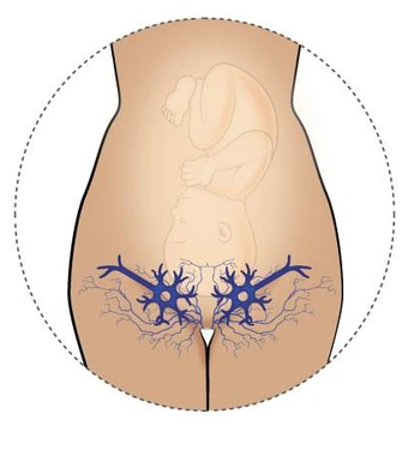
31 Aug Vulval varicosities during pregnancy
During pregnancy, vulval varicosities are very common. They happen when the veins in the vulva become engorged and swell.
They may present as:
- Swelling, ache, heaviness or bump around the vagina and vulval region
They are often due to:
- the extra blood volume in your body
- hormonal changes causing the relaxing of large veins
- hormonal changes causing softening of the connective tissue
- ongoing growth and increased weight of your baby, placing pressure onto the perineum/pelvic floor
- constipation during pregnancy – straining
How can you manage or prevent this condition?
- Firstly – DO NOT PANIC – in most cases vulval varicosities will completely resolve and tissues will return to normal with the following management (and prevention!) strategies and with time
- Avoid prolonged ‘static’ standing – ‘static’ standing can cause blood flow/fluid in veins to slow, and can exacerbate the feeling of heaviness
- Try to walk around, alternate sit and standing
- Adopt resting positions across the day – antigravity positions, where the perineum/pelvic floor (ie. floor of your core) is ‘offloaded’.
- This can significantly reduce your symptoms, even if you adopt these positions for 5-10 minutes, a few times a day.
- In these positions, you can complete a few gentle pelvic floor squeezes to help with blood flow
(only complete pelvic floor squeezes if you know you are activating correctly – see previous blogs re this!)
- Ice
- Try wetting regular pads, then freezing them
- Once frozen, place a tissue or wipe over the top and insert into your undies.
- Ice for 15 every 2-3 hours (approximately) – even 1x a day may help eg in evening
- Remember – ice when you have time to rest/stay relatively still, we do not want rubbing/irritation to the area
- Avoid deep squats, lifting heavy items, or any activity that causes you to tense your body/hold your breath – as these can cause further downward forces onto the perineum.
- If you are able, ‘pre-squeeze’ your pelvic floor before doing any of the above activities. This can lessen the load onto the pelvic floor and perineum
- Avoid constipation and straining to empty your bowels
- You can use hand pressure to support the vulva area and perineal area while emptying your bowels to help
- Speak to a professional if straining to empty your bowels to put a plan in place to help manage and prevent constipation
